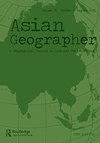青藏高原东南部贡嘎山脉树木生长与冬季气温的差异
IF 2.2
Q2 GEOGRAPHY
引用次数: 9
摘要
近几十年来,树木生长对温度的敏感性降低,通常被称为树木年轮“散度问题”,已经在世界许多地方观察到,这对树木气候重建的有效性提出了挑战。在不同的环境中,分异的表现形式和具体原因各不相同,但对青藏高原分异的研究很少。本文报道了青藏高原东南部贡嘎山乔其蓝(Abies georgei Orr)和西藏冷杉(Sabina tibetica)两种温度敏感的环宽年代学。在树木年轮和最低温度之间发现了显著的正相关,特别是在前一个冬天(去年12月到今年3月)。在20世纪后期发现了明显的局地温度变暖,最低温度的上升速度快于平均和最高温度。同时,我们的采样点在2003年以后观测到树轮发散问题。对冬季温度敏感性的丧失与对当前(以前)生长季节温度的正(负)响应的加强是一致的,这表明了我们的站点的差异的复杂性和可能的多重因果关系。本文章由计算机程序翻译,如有差异,请以英文原文为准。
Tree growth divergence from winter temperature in the Gongga Mountains, southeastern Tibetan Plateau
ABSTRACT The reduced sensitivity of tree growth to temperature in recent decades, commonly known as the tree-ring “divergence problem”, has been observed in many places of the world, which challenges the validity of dendroclimatic reconstructions. The manifestation and specific causes of the divergence vary in different environments, yet few studies have attempted to investigate its occurrence on the Tibetan Plateau. Here we report two temperature-sensitive ring-width chronologies of Abies georgei Orr and Sabina tibetica in the Gongga Mountains, southeastern Tibetan Plateau. Significant positive correlations were detected between tree-rings and minimum temperatures, in particular in the prior winter (previous December to current March). Pronounced warming of local temperature was identified in the late twentieth century, with the minimum temperature increasing more rapidly than the mean and maximum temperatures. Concurrently, the tree-ring divergence problem was observed after 2003 at our sampling sites. A loss of sensitivity to winter temperature is coincident with a strengthening of positive (negative) response to the current (previous) growing season temperatures, indicating the complexity and possible multi-causality of the divergence at our sites.
求助全文
通过发布文献求助,成功后即可免费获取论文全文。
去求助
来源期刊

Asian Geographer
GEOGRAPHY-
CiteScore
3.30
自引率
0.00%
发文量
7
期刊介绍:
Asian Geographer disseminates knowledge about geographical problems and issues focusing on Asia and the Pacific Rim. Papers dealing with other regions should have a linkage to Asia and the Pacific Rim. Original and timely articles dealing with any field of physical or human geographical inquiries and methodologies will be considered for publication. We welcome, for example, submissions on people-environment interactions, urban and regional development, transport and large infrastructure, migration, natural disasters and their management, environment and energy issues. While the focus of the journal is placed on original research articles, review papers as well as viewpoints and research notes under the category of “Asian Geography in Brief” are also considered. Review papers should critically and constructively analyse the current state of understanding on geographical and planning topics in Asia. The ‘Asian Geography in Brief’ section welcomes submissions of applied geographical and planning research about Asia. The section aims to showcase (1) the diverse geography and planning of Asia; and (2) the diverse geographical and planning research about Asia. The journal will also publish special issues on particular themes or areas. Book reviews can be included from time to time.
 求助内容:
求助内容: 应助结果提醒方式:
应助结果提醒方式:


